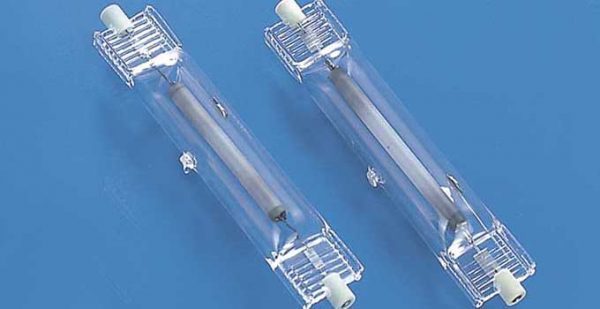Metal halide lights
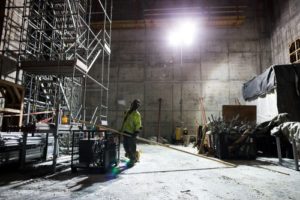 Metal halide lamps are an important member of high-intensity gas discharge lamps. With the modernization of our country, especially the rapid development of urbanization, and the continuous improvement of people’s requirements for the quality of lighting, metal halide lamps are Features such as luminous flux, high luminous efficiency, high luminous intensity, high color rendering, multi-tone, multi-variety, and long life are favored by people and will play more and more important roles. However, the manufacturing process of metal halide lamps is relatively complicated, and the requirements for raw materials and supporting parts are high, which makes the cost of lamp manufacturing and the cost of one-time investment high.Therefore, metal halide lamps are still a continuous improvement and continue to improve. New high-intensity gas discharge light sources of new products are continuously introduced.
Metal halide lamps are an important member of high-intensity gas discharge lamps. With the modernization of our country, especially the rapid development of urbanization, and the continuous improvement of people’s requirements for the quality of lighting, metal halide lamps are Features such as luminous flux, high luminous efficiency, high luminous intensity, high color rendering, multi-tone, multi-variety, and long life are favored by people and will play more and more important roles. However, the manufacturing process of metal halide lamps is relatively complicated, and the requirements for raw materials and supporting parts are high, which makes the cost of lamp manufacturing and the cost of one-time investment high.Therefore, metal halide lamps are still a continuous improvement and continue to improve. New high-intensity gas discharge light sources of new products are continuously introduced.
In last years, some new progress has been made in metal halide lamps, and some new applications have been opened up.that provides users with powerful, energy efficient illumination. This weather proof LED fixture is marine listed with an IP66 waterproof rating, T4A temperature rating and UL certifications, making it an ideal elevated lighting system in flammable work sites, manufacturing plants, marine locations and other hazardous locations.
Multifunctional metal halide lights
Working environment of metal halide lamps
 The HAL-TRN-400-220V-50Hz is a metal halide hazardous area light fixture that is suitable for use in wet outdoor environments, perfect for mounting onto boat docks, building exteriors and other outdoor work spaces. The metal halide lamp provides 45,000 lumens of wide flood configured illumination. A thermal-shock and impact resistant door glass with pressure-cast copper-free aluminum door frame and high temperature silicone rubber seal protects the metal halide bulb. The lamp socket is a specification grade mogul base porcelain unit with heavy gauge brass, and the reflectors are a double segment compound parabolic design with Alzak® finish for maximum efficiency.
The HAL-TRN-400-220V-50Hz is a metal halide hazardous area light fixture that is suitable for use in wet outdoor environments, perfect for mounting onto boat docks, building exteriors and other outdoor work spaces. The metal halide lamp provides 45,000 lumens of wide flood configured illumination. A thermal-shock and impact resistant door glass with pressure-cast copper-free aluminum door frame and high temperature silicone rubber seal protects the metal halide bulb. The lamp socket is a specification grade mogul base porcelain unit with heavy gauge brass, and the reflectors are a double segment compound parabolic design with Alzak® finish for maximum efficiency.
Performance of metal halide lamps
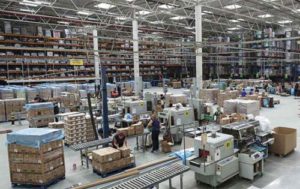 In order to expand the popularization and application of metal halide lamps, the internal performance of the bulbs has been improved (mainly the starting performance and lumen maintenance performance), so that the lamp can work not only on high voltage mercury lamp supporting electrical appliances, but also on high pressure sodium lamps. Work on supporting appliances. This makes it easier to replace high-pressure sodium or high-pressure mercury lamps with metal halide lamps. When the high-pressure sodium lamp is replaced with a metal halide lamp of the same specification, the low color temperature (1 950K) and low color rendering (Ra = 20) of the high-pressure sodium lamp have greatly improved the performance (4 000K, Ra = 65). This greatly improves the lighting environment, while slightly reducing light efficiency and life. Similarly, when the high-pressure mercury lamp is replaced with a metal halide lamp of the same specification, the color rendering (Ra = 40) is greatly improved (Ra = 65), and the light efficiency is greatly improved. (0.5 to 1 times), the average life of the lamp is also similar. Therefore, in some developed countries, this improved metal halide lamp is replacing high pressure sodium lamp or high pressure mercury lamp.
In order to expand the popularization and application of metal halide lamps, the internal performance of the bulbs has been improved (mainly the starting performance and lumen maintenance performance), so that the lamp can work not only on high voltage mercury lamp supporting electrical appliances, but also on high pressure sodium lamps. Work on supporting appliances. This makes it easier to replace high-pressure sodium or high-pressure mercury lamps with metal halide lamps. When the high-pressure sodium lamp is replaced with a metal halide lamp of the same specification, the low color temperature (1 950K) and low color rendering (Ra = 20) of the high-pressure sodium lamp have greatly improved the performance (4 000K, Ra = 65). This greatly improves the lighting environment, while slightly reducing light efficiency and life. Similarly, when the high-pressure mercury lamp is replaced with a metal halide lamp of the same specification, the color rendering (Ra = 40) is greatly improved (Ra = 65), and the light efficiency is greatly improved. (0.5 to 1 times), the average life of the lamp is also similar. Therefore, in some developed countries, this improved metal halide lamp is replacing high pressure sodium lamp or high pressure mercury lamp.
Lights and Lighting
High efficiency metal halide lamp
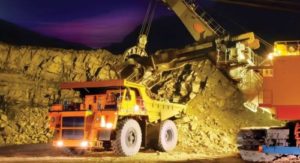 This high bay unit is IP66 rated, dust-proof, protected against high pressure jets and temporary submersion, and is resistant to damage from vibration and impacts. A hardened glass globe protects the internal LEDs. A special heat dissipating design paired with advanced LED technology helps this unit achieve a 55,000+ hour rated lifespan and 80% lumen retention. The EPHL-HHB-400W-LED is offered in wall, ceiling, pendant or stanchion mount and features a convenient ¾” NPT conduit entrance.
This high bay unit is IP66 rated, dust-proof, protected against high pressure jets and temporary submersion, and is resistant to damage from vibration and impacts. A hardened glass globe protects the internal LEDs. A special heat dissipating design paired with advanced LED technology helps this unit achieve a 55,000+ hour rated lifespan and 80% lumen retention. The EPHL-HHB-400W-LED is offered in wall, ceiling, pendant or stanchion mount and features a convenient ¾” NPT conduit entrance.
ScI 3-Nal metal halide lamps are the most common metal halide lamps currently used in North America and China. They are characterized by high light efficiency and long life. However, this type of lamp requires a CWA circuit. Type circuit or LC circuit) to achieve a better lighting effect. This circuit is equipped with a magnetic leakage boost ballast and a working capacitor, which is costly and cumbersome. Recently, various lamp manufacturers in the United States have successively improved and improved the performance of such lamps. After improvement
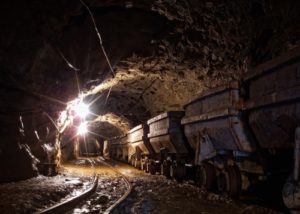 The lamp is called a Plus Start metal halide lamp. The discharge tube of this lamp does not have a starting electrode (see Figure 1). By filling a small amount of tritium gas in the discharge tube or installing a miniature UV tube outside the discharge tube, the lamp is easily started by the trigger. The role of krypton gas and UV tube is to make the initial ionization in the discharge tube, which can reduce the starting voltage of the lamp. Venture Lighting Corporation of the United States has made great improvements to the structural shape of the discharge tube. See figure 1 b): The shape of this discharge tube is an ellipsoidal cavity, which can match the shape of the discharge arc, and can obtain a uniform tube wall temperature distribution; the ellipsoidal tube shell is also more pressure-resistant than the general cylindrical tube shell Therefore, it can work under higher metal vapor pressure. At the same time, the electrode sealing part of the discharge tube has a small volume, which reduces the thermal conductivity loss and increases the temperature of the cold end of the discharge tube. These structures
The lamp is called a Plus Start metal halide lamp. The discharge tube of this lamp does not have a starting electrode (see Figure 1). By filling a small amount of tritium gas in the discharge tube or installing a miniature UV tube outside the discharge tube, the lamp is easily started by the trigger. The role of krypton gas and UV tube is to make the initial ionization in the discharge tube, which can reduce the starting voltage of the lamp. Venture Lighting Corporation of the United States has made great improvements to the structural shape of the discharge tube. See figure 1 b): The shape of this discharge tube is an ellipsoidal cavity, which can match the shape of the discharge arc, and can obtain a uniform tube wall temperature distribution; the ellipsoidal tube shell is also more pressure-resistant than the general cylindrical tube shell Therefore, it can work under higher metal vapor pressure. At the same time, the electrode sealing part of the discharge tube has a small volume, which reduces the thermal conductivity loss and increases the temperature of the cold end of the discharge tube. These structures
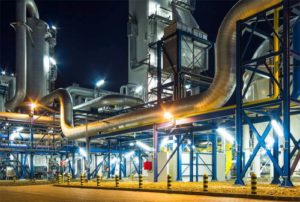 The improvement of the lamp improves the luminous efficiency of the lamp, improves the lumen maintenance rate, improves the light color consistency and the life of the lamp. At present, the process and equipment have been improved. The discharge tube without exhaust pipe can be manufactured, which further improves the light and color consistency of the product. The range of lamp specifications is 50-450 W. This new structure lamp with conventional metal halide
The improvement of the lamp improves the luminous efficiency of the lamp, improves the lumen maintenance rate, improves the light color consistency and the life of the lamp. At present, the process and equipment have been improved. The discharge tube without exhaust pipe can be manufactured, which further improves the light and color consistency of the product. The range of lamp specifications is 50-450 W. This new structure lamp with conventional metal halide
Compared with the lamp (ScI3-Nal): the luminous flux is increased by 20%, the light attenuation is improved by 40%, and the average life is increased by 50%. The main performance of Plus Start metal halide lamps and ordinary metal halide lamps (ScI3-Nal) is the lumen maintenance.
Normal Metal Halide Light Decay Curves
Metal halide lamp lighting circuit can use the general inductive ballast plus trigger circuit, compared with the CWA circuit, the lamp current waveform is better (see Figure 3), the circuit power consumption is low. If the CWA circuit is used, it will be beneficial to the stability of the lamp power and increase the lumen maintenance rate and life of the lamp when the power supply fluctuates greatly.
New developments of ceramic metal halide lamps Since the introduction of low-power (35 ~ 150 W) ceramic metal halide lamps, they have higher light efficiency, longer life, and better performance than quartz metal halide lamps. Color performance, more compact size, and its high stability have developed rapidly in recent years. Some developed countries have used low-power metal halide lamps for commercial lighting. With the continuous expansion of production scale and continuous reduction of production costs, not only can it replace quartz metal halide lamps in a large range, but also expand its application field and become a most promising light source. In recent years, some major lighting companies have been working on the development of medium power ceramic metal halide lamps. The main technical difficulty lies in the opening of the ceramic tube shell
hair. It is a ceramic tube structure for low power lamps. Metal halides will condense at the corners of the tube, which will not only affect the light output, but also increase the lamp voltage. 250 W, 400 W medium power ceramic metal halide lamps have been launched on the market.
Another trend of ceramic metal halide lamps is the development of lower power, more compact light sources, and 20 W ceramic metal halide lamps will soon be introduced. This kind of lamp adopts electronic ballast, which can be formulated into high-grade office lighting fixtures. It can be used in high-end business office applications and may also enter the field of home lighting. Another application is for automotive lighting.
Hg-free metal halide lights
 In high-intensity gas discharge lamps, especially in metal halide lamps, mercury is one of the main filling materials in the lamp. Under the set lamp power, the role of mercury filling is to increase the voltage of the lamp and reduce the lamp current. To improve the efficiency of the lighting system. As we all know, mercury is a harmful material to the environment. After entering the new century, people will try to exclude the use of toxic and harmful materials in the production of products to benefit humanity. Therefore, the research topic of mercury-free metal halide lamps came into being. At present, some progress has been made. Change the molar ratio of different metal halides. Mercury-free metal halide lamps show lower lamp voltage and light efficiency compared to mercury-containing metal halide lamps. It was found in experiments with mercury-free ScI 3-Nal metal halide lamps. The lamp voltage will increase as the molar ratio of ScI 3 to Nal increases, but the optimal value of light efficiency appears when the molar ratio of ScI 3 is 26%.
In high-intensity gas discharge lamps, especially in metal halide lamps, mercury is one of the main filling materials in the lamp. Under the set lamp power, the role of mercury filling is to increase the voltage of the lamp and reduce the lamp current. To improve the efficiency of the lighting system. As we all know, mercury is a harmful material to the environment. After entering the new century, people will try to exclude the use of toxic and harmful materials in the production of products to benefit humanity. Therefore, the research topic of mercury-free metal halide lamps came into being. At present, some progress has been made. Change the molar ratio of different metal halides. Mercury-free metal halide lamps show lower lamp voltage and light efficiency compared to mercury-containing metal halide lamps. It was found in experiments with mercury-free ScI 3-Nal metal halide lamps. The lamp voltage will increase as the molar ratio of ScI 3 to Nal increases, but the optimal value of light efficiency appears when the molar ratio of ScI 3 is 26%.
In order to improve the color change caused by the lack of mercury, a small amount of InI was added to this mercury-free metal halide lamp to obtain the same light color as the mercury-filled metal halide lamp.
Filled with new metal materials to replace mercury
 From a physics perspective, if you want to replace mercury in HID lamps, you need to meet certain conditions, such as: a large momentum transfer cross section for electron scattering, a large neutral particle density, and a large excitation and ionization energy, so that The lamp voltage rises and has a relatively high light efficiency, and can also supplement the chromaticity of mercury-free radiation. In addition, this material should also have a small impact on electrodes, tube walls, and discharge luminescent materials. Through experiments, it was found that the metal element Zn can meet the above conditions. Due to the low energy level and large heat loss of Zn, it is necessary to work under high wall load (the wall temperature is above 1 500 ℃)Therefore, ceramic tubes (Al2O3) are used as the wall material for the discharge tube. The test lamp uses NaI-TlI-InI 3 as the light-emitting material, Ar as the starting gas, and Zn as the buffer material for low-power ceramic metal halide lamps. The light efficiency of the lamp is 92 lm / W, and the color temperature is 2 900 K, Ra. = 83. The parameters of the mercury-filled metal halide lamp of the same power are: light efficiency = 1 00 1m / W, color temperature = 3 000 K, Ra = 84. In addition, Zn can be used instead of mercury in ScI 3-NaI type metal halide lamps for experiments, and similar effects can be obtained.
From a physics perspective, if you want to replace mercury in HID lamps, you need to meet certain conditions, such as: a large momentum transfer cross section for electron scattering, a large neutral particle density, and a large excitation and ionization energy, so that The lamp voltage rises and has a relatively high light efficiency, and can also supplement the chromaticity of mercury-free radiation. In addition, this material should also have a small impact on electrodes, tube walls, and discharge luminescent materials. Through experiments, it was found that the metal element Zn can meet the above conditions. Due to the low energy level and large heat loss of Zn, it is necessary to work under high wall load (the wall temperature is above 1 500 ℃)Therefore, ceramic tubes (Al2O3) are used as the wall material for the discharge tube. The test lamp uses NaI-TlI-InI 3 as the light-emitting material, Ar as the starting gas, and Zn as the buffer material for low-power ceramic metal halide lamps. The light efficiency of the lamp is 92 lm / W, and the color temperature is 2 900 K, Ra. = 83. The parameters of the mercury-filled metal halide lamp of the same power are: light efficiency = 1 00 1m / W, color temperature = 3 000 K, Ra = 84. In addition, Zn can be used instead of mercury in ScI 3-NaI type metal halide lamps for experiments, and similar effects can be obtained.
Charge high pressure xenon
 Ultra-high pressure spherical xenon lamp is an ideal point light source for projection lighting. The lamp is filled with high-pressure xenon gas (506. 625 ~ 1013. 25kPa). However, the light efficiency of this lamp is low (30-40 lm / W), and the lamp voltage is also low. If a metal halide is charged in a spherical xenon lamp, not only the light efficiency can be improved, but also the lamp voltage can be increased to improve the efficiency of the lighting system. Actually, the automobile metal halide lamp developed by this method (the lamp is filled with a certain amount of mercury to increase the lamp voltage) has been put into use. If the lamp is not filled with mercury, it can be made into a mercury-free automobile metal halide lamp. Correspondingly, the lamp voltage is low, and the light efficiency and light color performance are similar to mercury-filled lamps. The parameters of the two lamps are compared in Table 5. After the metal halide lamp is filled with high-pressure xenon gas, the total pressure in the lamp tube reaches tens of atmospheric pressure when the lamp is in operation, so this kind of lamp can only be made into a short-arc or middle-arc lamp with a spherical structure.
Ultra-high pressure spherical xenon lamp is an ideal point light source for projection lighting. The lamp is filled with high-pressure xenon gas (506. 625 ~ 1013. 25kPa). However, the light efficiency of this lamp is low (30-40 lm / W), and the lamp voltage is also low. If a metal halide is charged in a spherical xenon lamp, not only the light efficiency can be improved, but also the lamp voltage can be increased to improve the efficiency of the lighting system. Actually, the automobile metal halide lamp developed by this method (the lamp is filled with a certain amount of mercury to increase the lamp voltage) has been put into use. If the lamp is not filled with mercury, it can be made into a mercury-free automobile metal halide lamp. Correspondingly, the lamp voltage is low, and the light efficiency and light color performance are similar to mercury-filled lamps. The parameters of the two lamps are compared in Table 5. After the metal halide lamp is filled with high-pressure xenon gas, the total pressure in the lamp tube reaches tens of atmospheric pressure when the lamp is in operation, so this kind of lamp can only be made into a short-arc or middle-arc lamp with a spherical structure.
Electrodeless metal halide lights
Electrodeless metal halide lamps are attractive for research and development due to their long life, high color rendering and light color stability, high efficiency, and compact structure. They may also be developed into mercury-free metal halide lamps. .
Inductive coupling
 The inductive coupling system is composed of a discharge tube and a coil inputting a high-frequency current around the discharge tube. The arc plasma generated by this system is close to the tube wall of the discharge tube, making the tube wall temperature much higher than that of a general metal halide lamp. The metal will interact with the tube wall and generate free halogens, increasing discharge instability and The lamp voltage rises. Adding materials such as SnI 2 or SbI 3 as the adsorbent of free halogen at high tube wall temperature in the shell can maintain the stability of the starting voltage and have a better lumen maintenance rate. The experimental characteristics of this inductively coupled metal halide lamp are shown in Table 6. Characteristics of induction coupled metal halide lamps Type Power (W) Light efficiency (lm / W) Color temperature (K) Ra High efficiency type 400 180 5 000 74 Long life type 300 145 3 800 58 Actually due to the shading of the induction coil And the reactance loss, the actual efficiency of the high-efficiency type is lower, and its light efficiency is about 150 lm / W.
The inductive coupling system is composed of a discharge tube and a coil inputting a high-frequency current around the discharge tube. The arc plasma generated by this system is close to the tube wall of the discharge tube, making the tube wall temperature much higher than that of a general metal halide lamp. The metal will interact with the tube wall and generate free halogens, increasing discharge instability and The lamp voltage rises. Adding materials such as SnI 2 or SbI 3 as the adsorbent of free halogen at high tube wall temperature in the shell can maintain the stability of the starting voltage and have a better lumen maintenance rate. The experimental characteristics of this inductively coupled metal halide lamp are shown in Table 6. Characteristics of induction coupled metal halide lamps Type Power (W) Light efficiency (lm / W) Color temperature (K) Ra High efficiency type 400 180 5 000 74 Long life type 300 145 3 800 58 Actually due to the shading of the induction coil And the reactance loss, the actual efficiency of the high-efficiency type is lower, and its light efficiency is about 150 lm / W.
Microwave excitation
The plasma of the microwave excited discharge is the same as that of the inductive coupling type, but the discharge is excited by the microwave system. The test light source has been made of InBr 3 or CsBr, which has better color rendering performance. Microwave-excited InBr 3 lamp.Characteristic parameters of microwave excited InBr 3 lamp Input power (W) Light effect (lm / W) Color temperature (K) Ra
Color-changeable metal halide lights
It is well known that the color temperature of metal halide lamps will change during the life, or between the same batch of lamps, or between different batches of lamps, or due to changes in operating conditions. This change in color temperature will affect its application. A method to control the color change of metal halides has been found and has been proved. By adjusting the current waveform load cycle of the square wave electronic ballast to change the light output of the metal halide lamp, the color of the lamp output spectrum can be controlled. The frequency of the square wave electronic ballast is between 200 and 600 Hz, and the load cycle of the voltage and current waveforms controls the rectifier crystal through the time circuit.
The tube switch is controlled. In this way, the lamp can be moved from 50% to 90% under a constant power load. The current load waveform. When the load waveform is adjusted, the color temperature will be adjusted accordingly. For example: the color temperature design value of the metal halide lamp can be adjusted from 3 500 K to 4 300 K; or 2 800 K can be adjusted to 3 500 K. We can also use the square wave electronic ballast current load waveform adjustment technology to keep the color temperature change of the metal halide lamp unchanged (that is, ΔT ≈ 0K).
Made of colorless metal halide lamps. In addition, tests show that under 50% and 90% current load cycles, there is no significant effect on the lumen maintenance of the lamp (that is, no significant damage to the electrodes), and the change to Ra is small. Of course, as the filling of the metal halide, the structure of the discharge tube, the lighting position and other factors change, the adjustment of the circulating current load waveform will also be different. Current load waveform 7 In other aspects, metal halide lamps are not only a process of gas discharge and radiation during ignition, but also a high-temperature chemical reaction process (that is, the decomposition and recombination process of metal halides). Strict requirements. The performance of metal halide lamps is closely related to the quality of these materials.
Tube Wall material
Generally, the discharge tube of metal halide lamps uses quartz tube materials. Under the high temperature state of discharge, metal halides will react with quartz to generate silicates and silicon compounds, resulting in reduction of metal elements and color drift; separation The silicon element will melt in the tungsten electrode, which deteriorates the electrode’s emission performance; the excess halogen makes discharge difficult. In addition, some metal ions (such as Na +) gradually penetrate through the tube wall during the life of the lamp, which will also deteriorate the performance of the lamp. These factors have limited the improvement of performance and life of quartz tube metal halide lamps. The transparent ceramic (Al2O3) is used as the tube shell of the metal halide lamp discharge tube, which can overcome the above defects and become an ideal tube wall material. However, the tube shape required to make a transparent ceramic tube into a discharge tube has complicated forming technology and expensive manufacturing cost. At present, transparent ceramics cannot be popularized and applied. A technology for coating a high-temperature protective film resistant to metal halide corrosion on the surface of quartz is also under continuous research and development. Experiments have shown that some materials (such as SiC, Si 3 N, AlN 涂敷) are coated on the surface by spark sputtering or chemical method, and after aging treatment, the films of these materials can be used as protective films for metal halides at high temperatures. . Tested SiC materials provide the best protection. Using this process technology, it can be used in electrodeless discharge lamps to produce long life and high stability electrodeless quartz metal halide lamps. It may also be popularized and applied to general quartz metal halide lamps.
Electrode material
Electrode materials are subject to halide attack in metal halide lamps, so the range of materials used is limited. The electrode materials currently used are only pure tungsten or thorium tungsten materials, and some people recommend using rare earth metal oxides to make tungsten electrode materials or new tungstate materials to improve the emission performance of the electrode and reduce the sputtering of the electrode material. Improve the light efficiency of the lamp and improve the lumen maintenance rate. China is a large country with rich rare earth resources.For example, if it can develop electrode materials containing rare earth oxides, andIt can be successfully used in metal halide lamps, and it will have a good development.
Metal halide material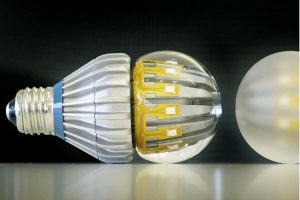
One of the work of metal halide materials is to continue to look for new metal luminescent materials or new metal materials to improve the photoelectric performance and application performance of the lamp. Another task is to choose the appropriate complex to greatly increase the vapor pressure of radiant metal elements at the same tube wall temperature, or to maintain the same metal element vapor pressure at lower tube wall temperatures. The former can improve the light color performance and luminous efficiency of the lamp; the latter can reduce the light attenuation and increase the life of the lamp. For rare earth metal halide
In terms of compounds, NaI, CsI, InI, etc. are considered good complexes. Therefore, developing new metal halide materials and finding suitable complexes is still an important work in the development of metal halide lamps.

